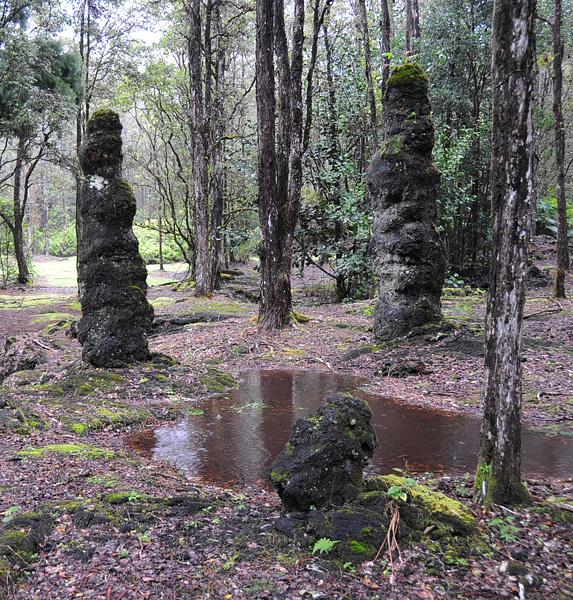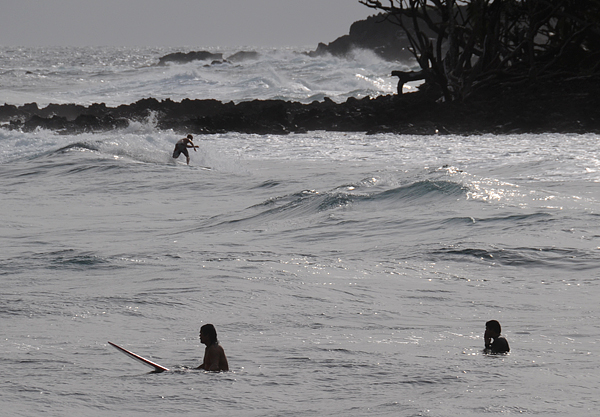We walked the rugged nature trail that meandered around the Hedonisia property through dense rain forest and past a gaping deep lava tube of unknown depth. A few years before one person rappelled down inside, but didn’t go beyond his rope length.
Around the grounds were other accommodation options. Inside The Barn were three tents erected on the wood floor, each numbered and each rentable as a place to stay. Outside was one other hut similar to ours, though its roof had caved in recently so it was temporarily in limbo. The Love Bus was a big yellow school bus, set up inside for sleeping arrangements. And on the property’s lower level were several large work sheds that had partial walls made of the remnants of a ragtag assortment of deceased backpacking tents, all stitched together into large tarps to keep out bugs and some rain. Scattered between all of these were natural rain forest trees and organic garden beds with labeled rows.
The communal concept also encouraged work-trade arrangements, where people could stay for free in return for volunteering time and energy to general maintenance or specific projects. Lee was one of these people, as was Lisa, and he was great to talk with. Tall with blonde dreadlocks and a shirtless Hawaiian surfer tan, he spoke eloquently about getting back in touch with each person and nature, while still encouraging and being integrated with the better aspects of technology and society but without the useless consumerism. It was refreshing to hear someone reference everything from Hieronymus Bosch to end-of-society survivalism, and be able to talk to an interesting range of these topics well beyond the generic stereotypes of crunchy granola lifestyles.
Bidding farewell to Hedonisia, we drove back into Pahoa for the Sunday Farmer’s Market, running between tents to get out of the downpours. We walked away with delicious macadamia / coconut cookies, Thai food, and the locally renowned green papaya salad. Driving further, we even came upon what was essentially a bake sale for the government. Really. There were folks on the side of the road trying to raise money for the Hawaiian government by selling stuff, with proceeds going to the government coffers. Or at least that’s what they and their large banner earnestly said.
Nearby Lava Tree State Park mixed geology with botany in an unusual way. When liquid pahoe-hoe lava had flowed around wet native ‘ohi’a trees, lava caked onto the tree trunks and left a thick crust as the lava continued flowing around and receded lower. This left free standing lava tubes, looking like hoodoos, and the tree molds still stood while the original center trees were long gone. A pretty path wound through the living and rock forests. Like many places around the island, feral chickens clucked around too. Amazing how many tourists took as many pictures of the chickens as they did of the tree molds; the photographers looked like classic city slickers who thought the chickens were exotic birds.
We then went out to the eastern-most section of the island, along rutted gravel side roads and eventually to paved coastal roads with views that appeared here and there through the forest.
The Kapoho Tide-pools were a long series of slightly warmed pools that lined the coast and housed many types of fish and coral.
For a far toastier swim, we luxuriated in the manmade Ahalanui, filled by a volcanically heated fresh water spring but continually intermixed with cold ocean salt water through a sea wall. The result: temperatures in the low to mid 90 degrees Fahrenheit and good swimming. The temperature and salinity differences were actually visible: the warmer and lighter fresh water on top with the colder and heavier salt water below, forming a visible shimmering underwater interface that was barely visible when I concentrated on finding it.
Isaac Hale Beach was an area for the locals, as was much of this eastern and lesser traveled part of the island. Fishermen launched boats while surfers and boogie boarders rode the waves as their friends watched. Music from car stereos filled the air, picnics and food were all around, and it was the place to be on a sunny Sunday afternoon.
We continued ahead to the recent lava-strewn mountainside below the active Pu’u O’o Crater. This crater had been steadily erupting and flowing down to the ocean for the past twenty five years, completely erasing a town and several large subdivisions in the process. A county road had actually been partially semi-repaired between eruptions for a few miles in to this area, though you had to ignore the official metal “Authorized Personnel Only”, “No Trespassing”, and dire warning signs at the initial roadblock. Everybody else “in the know” ignored them, and there were welcoming county workers near the lava field viewing area at the end, so it must have just been their weird way of keeping out more tourists. A couple times the paved road would go directly into a long lava flow and then rise up onto the flow via a rugged bulldozed thin road across the jagged surface, surreally landing back down onto smooth pavement after traversing on lava above the buried original roadway for a half mile.
Along the way, a few small houses had been constructed directly on top of the hellishly barren lava field. Many of those home owners were original owners of the land before the recent eruptions, and they decided to try again and tempt fate instead of moving elsewhere. There were no utilities to the houses, and they only had outhouses since there was no soil for a septic system. Also, several locals told us those areas on the east side had an unusually high number of people trying to hide from law enforcement agencies, and in some cases trying to do the opposite by hiding from organized crime via the Federal Witness Protection Program.
At road’s end, county workers were onsite to guide people to a lava viewing area at the ocean’s edge. The steam plume was a half mile distant, rising from the ocean where lava rivers vaporized ocean water into the air. To tempt getting in close to the actual lava, one would have had to arrive earlier in the day (before 2:00 pm when the county worker arrive) and hike out across the lava beds, hoping not to fall into any brittle crust to hot flowing lava below.
We joined in on the local spectacle of watching the steam cloud glow red with lava as night fell around us. Of course I didn’t wear any Gore-Tex and of course a drenching rainstorm came in. I hugged Karen with the wind to my back, protecting her from the shivering cold of the rain, with my camera sandwiched between us. So much rain came that it was flowing down my back, through the fabric of my pants, and filling my boots with water.
Eventually the rain subsided, and we got a good, though distant, show of Pu’u O’o lava shining eerily into the steam clouds by the dark ocean under dark clouds. Apparently sometimes the lava was directly visible in the lava fields coming down the mountain, though the rains tended to cool the surface more than usual and increase the rate of blackened crust a bit.
After the prior sleepless night of coqui frogs followed by a cold drenching at the lava fields, the plush bed at Country Goose B&B felt really good, an hour away at Volcano Village.




Leave A Comment